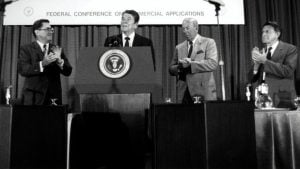Meaning and Features of a Political Party: A Political Party is an organisation that brings together candidates to run in elections in a certain country. A political party’s members run for office under the same banner. Members of a political party are likely to share similar political views, and parties may advocate certain philosophical or policy goals. As modern party organizations formed and expanded over the world over the previous several centuries, political parties have become a key feature of practically every country’s politics. A country with no political parties is highly uncommon.
In some nations, there is just one political party, whereas, in others, there are several. Parties are significant in both autocratic and democratic systems, while democracies often have more political parties than autocracies.
Parties can emerge from existing societal differences, such as those between the poorer and upper classes, and they can help to simplify the political decision-making process by pushing its members to work together. A political party typically consists of a party leader, who is in charge of the party’s activities; party executives, who may choose the leader and perform administrative and organizational tasks; and party members, who can volunteer to help the party, donate money to it, and vote for its candidates.
Political parties may be constituted in a variety of ways and connect with voters in a variety of ways. Citizens’ contributions to political parties are frequently restricted by law, and parties will occasionally rule in a way that benefits those who provide time and money to them.
Ideological objectives inspire many political parties. Liberal, conservative, and socialist parties compete often in democratic elections; other prominent ideologies of extremely significant political parties include communism, populism, nationalism, and Islamism.
To identify themselves with a certain philosophy, political parties in various nations typically use similar colours and symbols. Many political parties, on the other hand, may have no ideological affiliation and are instead focused on patronage, clientelism, or the rise of a single political entrepreneur.

Recommended: Meaning and types of a constitution
Meaning and Types of Party Systems
Political parties are common in both democratic and autocratic countries, and the political parties with the best chance of retaining power in a country frequently do not alter much from one election to the next. As a result, political parties in a nation may be thought of as collectively creating one of the country’s primary political institutions, known as a party system.
The number of parties and the types of parties that are most successful are two essential characteristics of a party system. These characteristics are intertwined with other important aspects of a country’s politics, such as how democratic it is, what limits its laws place on political parties, and what election methods it employs.
a. Non-Partisan System: Political parties do not exist or are not a significant element of the political system in a non-partisan system. There are just a few nations in the world that do not have political parties.
The creation of parties is expressly prohibited by law in several non-partisan countries. In autocratic nations, political parties may be outlawed to prevent power transitions. In Saudi Arabia, for example, a prohibition on political parties has been used to defend the monarchy.
Also see: Advantages and Disadvantages of non party system.
b. One-Party System: One political party control all of the power in a one-party system. In this arrangement, there is no rivalry. The candidates are nominated by a single party, and voters have just two options: not to vote at all or to write ‘yes’ or ‘no’ against the names of the party’s nominees.
Authoritarian governments and communist nations like China, North Korea, and Cuba have used this political system. This method was also common in the USSR before the collapse of communism.
Recommended: Advantages and Disadvantages of one party system
c. Two-Party System: Power transfers between two large, dominating parties in a two-party system. As a result, to win the election, the winner must receive the greatest number of votes. Please keep in mind that the highest number of votes does not imply a majority of votes.
As a result, smaller parties tend to combine with larger parties or withdraw from elections. Canada, the United States, and the United Kingdom all have parliamentary systems in which two parties have the majority of seats.
Recommended: Advantages and Disadvantages of a two party political system
d. Multi-Party System: The multi-party system is the third and most frequent type of governance. In such a system, three or more parties can take control of the government either individually or as part of an alliance.
If no one party wins a clear majority of parliamentary seats, multiple parties band together to create a coalition administration. A multi-party system is used in countries such as India and Nigeria. Some argue that a multi-party system frequently results in political instability in a country.
Also see: Advantages and Disadvantages of a multi party system
Top 4 Main Features/Characteristics of a Political Party
We can deduce some important features that every political party contains from the given definitions above. They are as follows:
1. Agreement on fundamental views and ideas: A political party is a group of people who have come together to have common interests. Men have differing viewpoints. This is due to a combination of variances in personal experience, emotions, temperament, character, and knowledge, as well as a love of battle and the drive to win. An individual’s beliefs and opinions are heavily influenced by his family traditions and social standing.

Men are communal by nature, like flocks of birds of the same plumage. If they want to exist in a political society, they must put aside their differences and agree on certain points of view. Like-minded people combine or gather together to create a party when they agree on some fundamental purposes and values in political, economic, and other affairs. No political participation is conceivable without agreement on fundamental goals, objectives, and ideals.
Also see: Ways of promoting national consciousness and unity
2. Organisation and leadership: If people with similar beliefs and values want to attain their goals and aspirations, they must organize themselves into a political entity. Without an effective organization, no meaningful result can be achieved in politics.

The party’s organization provides coherence, unity, and strength. It is the only thing that allows for coordinated effort and achievement. A political party is distinguished from a throng or a mob by this feature. A political party is a large-scale version of a sports club.
It features a cooperative and organized team attitude. Parties, on the other hand, differ in how they are organized. Some are extremely well-organized, while others are not. However, in today’s world, the overall trend is toward strict organization, discipline, and control.
A political party is similar to an army in that it is a combat force whose goal is to conquer and seize political power. As a result, organization and leadership are essential for political success.
Recommended: See why democracy is the best form of government
3. Constitutional Methods: Democracy is believed to be built on the foundation of political parties. A political party, albeit a fighting organization, does not fight with guns and missiles like an army. It, on the other hand, fights with constitutional tactics and in a peaceful manner.
The technique of political decision is compromise rather than total capitulation. Political parties use public speeches, gatherings, and demonstrations, persuasion and propaganda, and other methods to influence public opinion to gain power.
They urge people to elect one of the two parties to power. The majority rule determines which of them will form the government. The fate of a political party and its claim to form the government is decided at the voting box. Some political groups employ revolutionary or violent tactics. However, such a situation only emerges when people are denied self-government chances and the state system enables its party system to be abused or corrupted.
4. Promotion of national interests: A political party’s mission should be to promote national interests rather than sectarian, communal, or class objectives.
This is the key distinction between a political party and a faction, coterie, clique, or pressure group. While the party seeks the common benefit of the whole country, these organizations seek the special interests or selfish goals of a certain group, class, or segment of the country.

Edeh Samuel Chukwuemeka, ACMC, is a lawyer and a certified mediator/conciliator in Nigeria. He is also a developer with knowledge in various programming languages. Samuel is determined to leverage his skills in technology, SEO, and legal practice to revolutionize the legal profession worldwide by creating web and mobile applications that simplify legal research. Sam is also passionate about educating and providing valuable information to people.
It was really helpful and convenient